You may not find this terribly rewarding unless you're included here, so this is a good time for casual and random browsers to turn back before they get too caught up in the sweep and majesty of the proceedings and can't let go.
The plan is to luxuriate for twelve days in Viterbo, with enthusiastic sight-seeing in the region, and a few days tacked onto either side of that for getting there and back.
More Sightseeing in Viterbo (round two)

First things first (30 November 2016) -- Kristin's visiting friends (and the Artemisia Gentileschi exhibit) in Rome today, and our host Stefano is helping me to shift our accommodation to a larger flat to accommodate our friend, who's arriving tomorrow.

The view from the window

We're in the Violet apartment, which is very, very violet

That'll be Juan Carlos' room up the precarious staircase

The corner bedroom. At the Casa Vacanze La Suite del Borgo everything is tastefully done.

The violet kitchen from the precarious staircase

The Squirrel at her ease in the new surroundings (usually she hides in the armoire)

The street outside our door, the Via Scacciaricci (say that three times fast)

The Via Scacciaricci leading up to the Via San Pellegrino

We're just wandering about today, lonely as a cloud, intent eventually on visiting the Rocca or Fortress Albornoz at the northern end of the walled part of town.
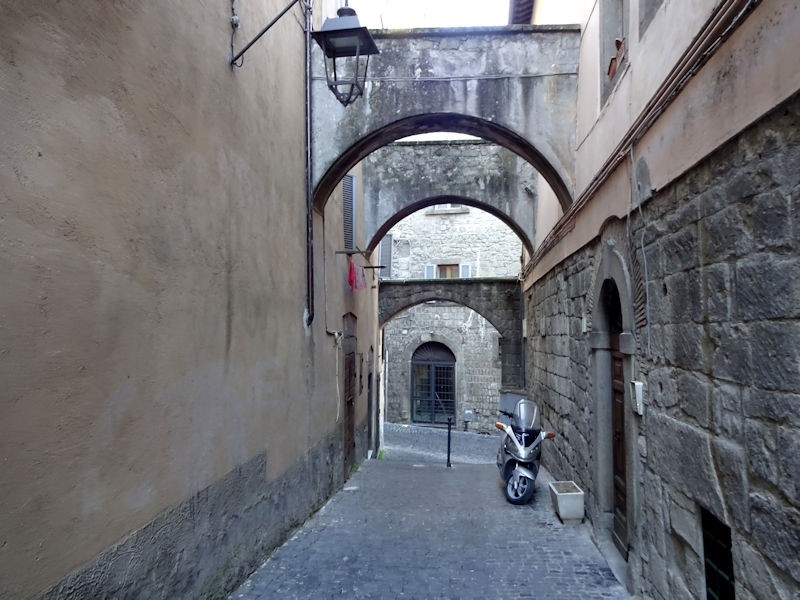
Back alleys still within the San Pellegrino medieval centre

The Chiesa del Gesù (also called the Chiesa di San Silvestro) is documented from 1080 but probably built as much as a century earlier, originally a far more important church in town, prominent here in what was once the main market square, the Piazza del Gesù. (The interior is simple and lovely, but I didn't get to see it.)
The wall-plaque above the truck on the left commemorates a medieval tragedy: In 1271, Henry "of Almain", son of Richard, 1st Earl of Cornwall, who was the son of King John and brother of King Henry III (and who had purchased election to the title of King of Germany, hence his son's "of Almain"), was passing this way and taking communion in this church. In 1265 he had assisted his father in the Second Barons' War in England, and had helped to behead and mutilate the rebellion's leader, Simon de Montfort, the 6th Earl of Leicester (son of the vicious Albigensian Crusader against the Cathar heretics in France), and Montfort's eldest son after the Battle of Evesham in 1265. Montfort's younger sons, Guy and another Simon, wandered Europe in exile for several years, but caught up with Henry of Almain in this church and murdered him on the altar. It appears from Dante, who puts Guy in the 7th Circle of Hell up to his neck in the river of boiling blood, that a statue of Henry, holding a casket containing the slain man's heart, was erected on London Bridge and venerated (Inferno, canto XII).
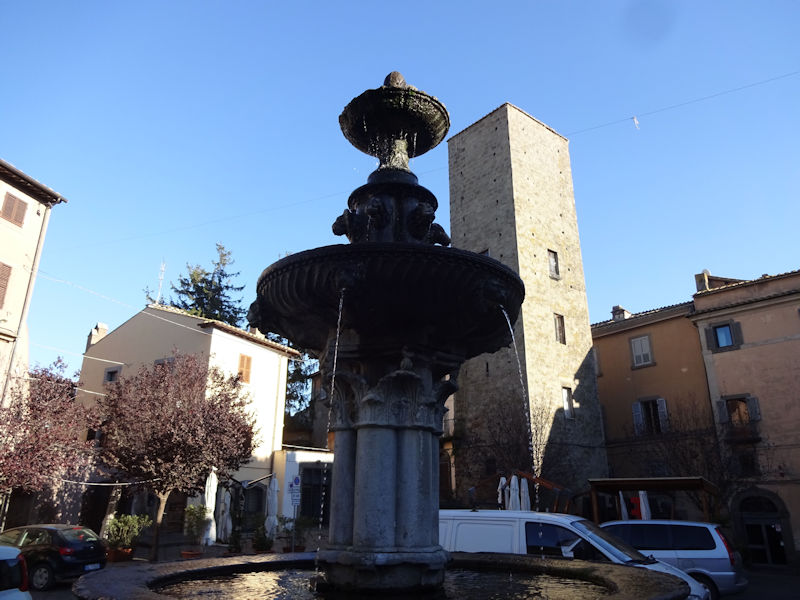
Up to the 13th century, the Piazza del Gesù was, in addition to the central market square, also the site of city administrative offices before the building of the Palazzo dei Priori up the street in the Plebiscite Square, as well as the palace of the ruling di Vico family in the 13th century. The fountain dates from 1450 but was renovated in 1923 using parts from a nearby convent.

The Torre del Borgognone in the Piazza del Gesù, dated uncertainly from the 11th to the 13th century, was once one of 197 civic towers in town (according to the info panel on the wall), built for family defense from the 11th century but increasingly in the 13th, of which 40 still remain after most were lowered or destroyed in more settled times. The length of the foot of Sir Angelo Borgognone (the 'Burgundian') is marked at the bottom of the tower, to be used as a standard unit of measurement to ensure that all the towers complied with city regulations.

An awful former fountain in the Via dei Pellegrini

The alleyway of the Via dei Pellegrini leads back to the Via San Lorenzo and the bridge to the Duomo and Papal Palace.

The 13th century Palazzo Farnese at the end of the bridge, acquired by the Farnese family in the mid-15th

Turning round and walking back northeastward along the Via San Lorenzo towards the present administrative centre of town, we pass the Chigi Palace, originally built by the powerful Roman family the Caetani (Benedetto Caetani was the controversial Pope Boniface VIII, d.1303, whom Dante despised so vividly) and acquired by the powerful Chigi banking dynasty in the early 16th century.

The Palace of the Podestà in the Piazza del Plebiscito, where the Via San Lorenzo continues to the right of the clock tower as the Via Roma

The Piazza delle Erbe, where the Via Roma becomes the Corso Italia, looking much the same as it did when we passed by here four days ago

Street scene

The Piazza Giuseppe Verdi, where the Corso Italia and the Via Marconi join to become the Via Fratelli Rosselli (named for two prominent anti-fascist brothers from Florence who were assassinated in Normandy by French fascists in 1937)

The small Church of St Mark, inaugurated in 1198 by Pope Innocent III and 15 cardinals -- people have always wondered how Innocent III and his 15 cardinals could ever have fit inside it at the same time. When built, it was outside the old city walls and served mainly local farmers.

The Viterbo Chamber of Commerce building. There is no city gate here, but turning left at the intersection ahead we continue along outside the city wall and turn in at . . .

. . . the Porta Fiorentina at the north end of the centro storico.

The Fontana di Piazza delle Rocca, in the eponymous piazza, was constructed by lava tufa and designed by Vignola.
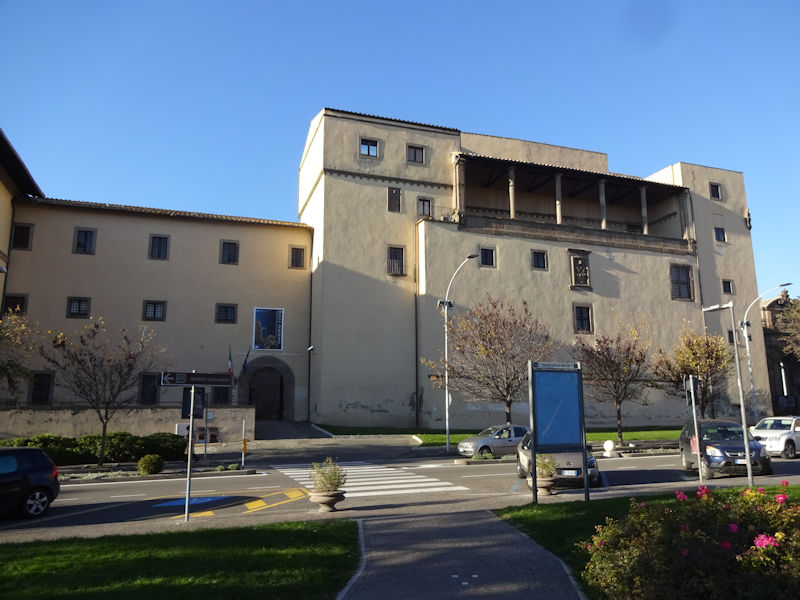
The Rocca, or fortress, was commissioned by Cardinal Albornoz, the Spanish churchman and the Avignon popes' military hitman in restoring the church's territorial hegemony over the restive Papal States of central Italy. He passed this way in the 1350s and took on Giovanni di Vico, Lord of Viterbo, of the Prefetti di Vico family, who had rebelled against the popes in the 1340s and carved out a fiefdom of his own in northern Lazio and Umbria, including Orvieto. Cleaning up after di Vico in 1354, the Cardinal established his peace-keeping urban stronghold here and went off to bring the papal message to cities in the Marche and Romagna regions.

The Rocca Albornoz also houses the Museo Nazionale Etrusco, and I'm keen to see all the neat local Etruscan heritage, but guess what, I'd forgotten to bring my wallet. We'll be back.

An elegant building across the Piazza delle Rocca, the groundfloor of which is occupied by an elegant yogurteria.
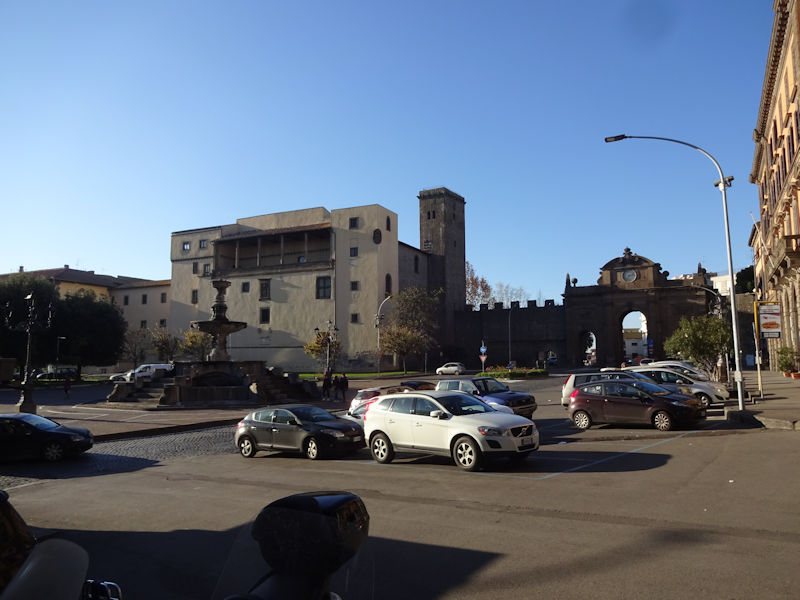
The Rocca, fountain, and Porta Fiorentina

The huge Basilica di San Francesco alla Rocca, built by the Franciscan order beginning in 1237, heavily damaged by Allied bombers in January 1944 but reopened in 1953 mostly in its original Romanesque effect, with the Baroque additions left off

The church interior (closed when I was there) is a simple Latin cross with a square apse -- several notable frescoes survive, as well as the funerary monument of Pope Adrian V (the one-month Pope), who died here in 1276. Convent buildings form a huge square out the back, and also on the left, now occupied by the Aviation Command of the Italian army.

Down the alleys to the Santuario di Santa Rosa, of glorious civic tradition

The Sanctuary of Santa Rosa. Santa Rosa of Viterbo was born in about 1233 and was spiritually precocious -- e.g., she brought her dead aunt back to life when she was only three, an impressive feat at any age. She tried to found her own monastery at 15, but it didn't work, so she lived basically as a recluse, praying all the time, but came out into the streets from time to time in a simple tunic telling everyone to be penitent and faithful to the pope. The Emperor Frederick II's people controled the city at that time, so in 1250 her family went into exile, but in December she predicted the Emperor's death and he died a week later. She tried to enter the Poor Clares monastery in Viterbo but couldn't come up with the admission fee. She died in 1251 of a heart condition, and in 1257 her remains were moved on the pope's orders to this monastic church which had refused her admission, and its name changed to hers. ["Although her skin is dark, the body of the saint is still flexible and the internal organs in good condition" -- authoritative source.]

The present church, unfortunately, dates from a 19th century reconstruction. St Rosa is now the patron saint of Viterbo, and since 1258 a major event in the city's religious and tourist year is a procession through the streets commemorating the transference of her remains. The tradition of carrying the "macchina" in the procession began in 1686, and nowadays every five years a new machine is built following a design competition. Every 3 September, the Macchina di Santa Rosa, a 5-ton 30-meter ornamented tower, nowadays boasting 3,000 electric lights and a statue of Rosa on top, is carried more than a kilometre through the old town by 100 men of the Sodality Facchini of Santa Rosa to the rapturous cheers of the crowds.
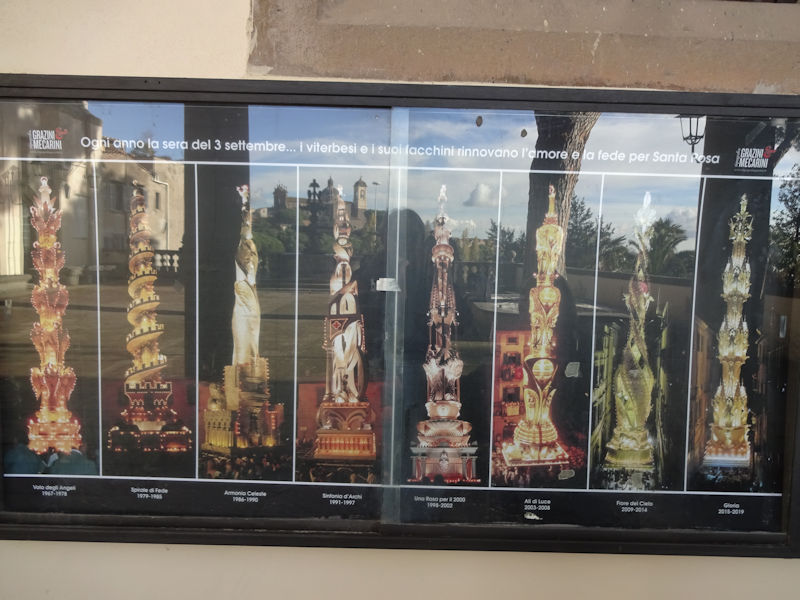
Some of the recent St Rosa machines (from a display in the courtyard of the Palazzo dei Priori). In 1801, alas, a lady in the crowd at the Fontana Grande whose jewels had been pickpocketed began shouting frantically and spooked some horses in the piazza, with 22 fatalities, and later that night the machine caught fire in the Piazza delle Erbe, so the procession was banned by the pope for ten years. In 1893 the procession was canceled because of rain and it turned out that anarchists had prepared to throw bombs along the route and never got the opportunity to do so.

The cute Chiesa di Santa Maria in Poggio -- Little Rosa's neighborhood church and her favorite, then in a small village outside the walls. It was here that Rosa was buried near the altar until the Pope ordered her moved a few streets over six years later. The church has gone through periods of abandonment and revival many times over the centuries, and the Allies hit it hard in January 1944.

The Chiesa di San Giovanni in Zoccoli, founded in the 12th century, a bit farther down Via Mazzini adjacent to the Piazza Dante Alighieri
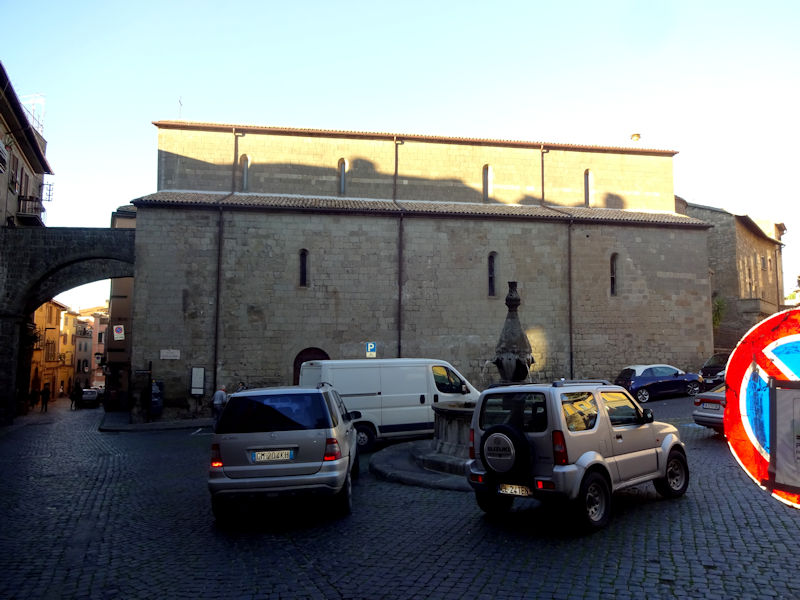
The Church of St John in Zoccoli and Piazza Dante
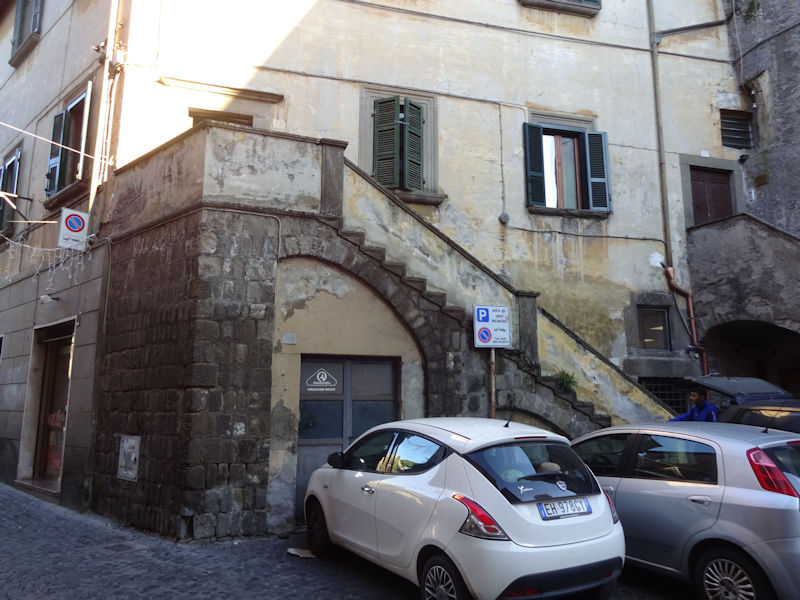
A good example of a profferlo, an external staircase to the main entrance on the first floor with a balcony protecting the space beneath, usually a shop front or workshop, for both functional and defensive purposes. The profferli, adapted from rural customs, made their appearance in the early 13th century and were a prominent feature in Viterbo and the region until the end of the 16th.

Sunlit churches along the Via delle Pace


Back to the Piazza Fontana Grande
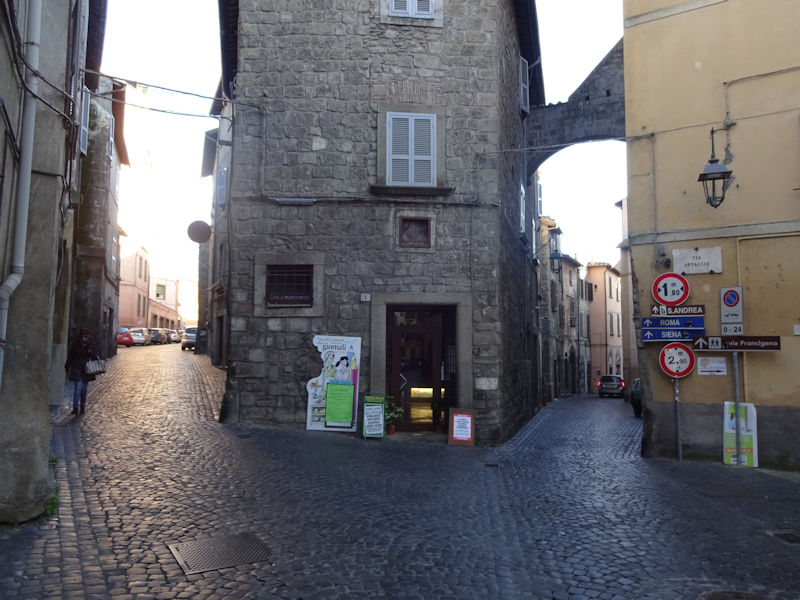

Forested palazzo along the Via Cardinal La Fontaine


A short cut home, and I've shortly got lost.
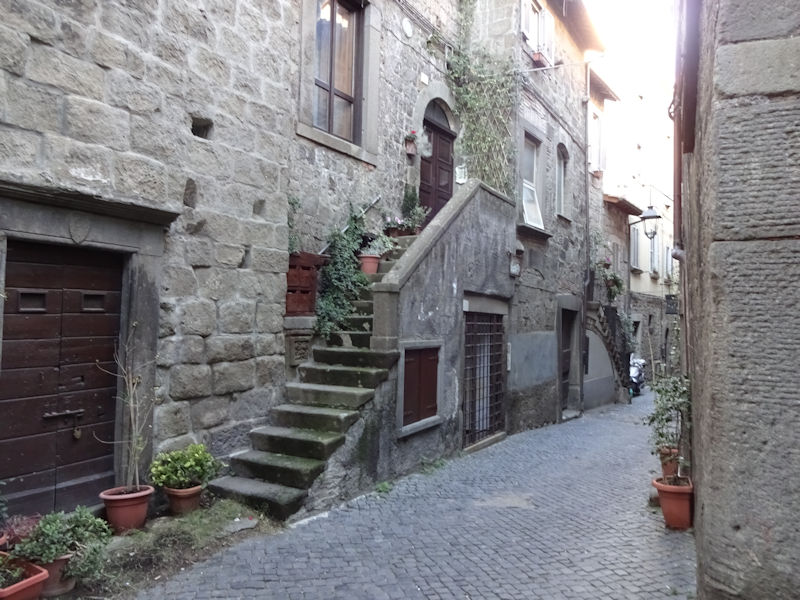
An exemplary profferlo. I'm still lost.

Saved. A sign for San Pellegrino in the tiny Via Madonna del Riposo
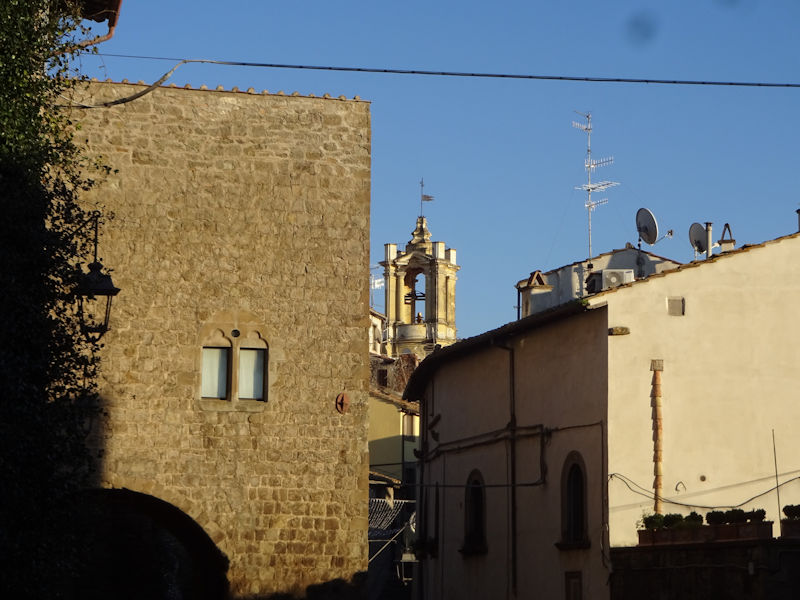
Nearly home

The Piazza San Pellegrino
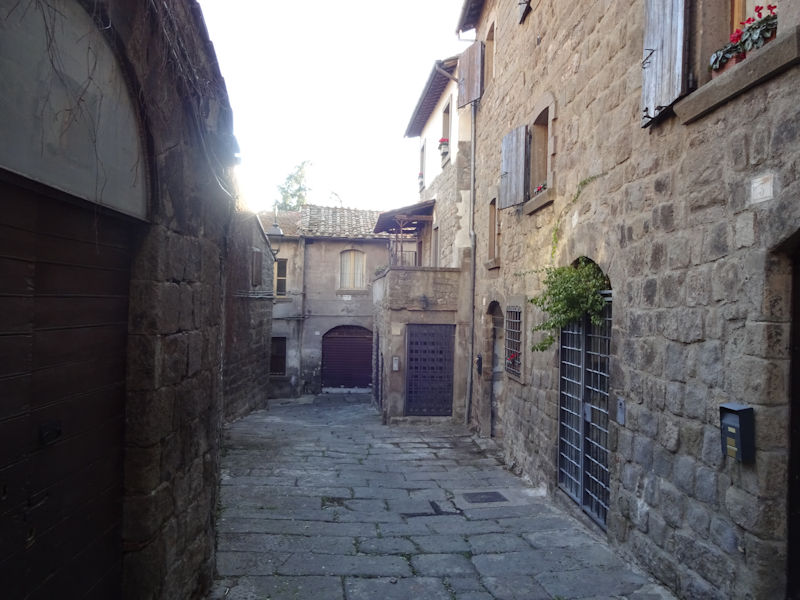
A short block down the Via Scacciaricci
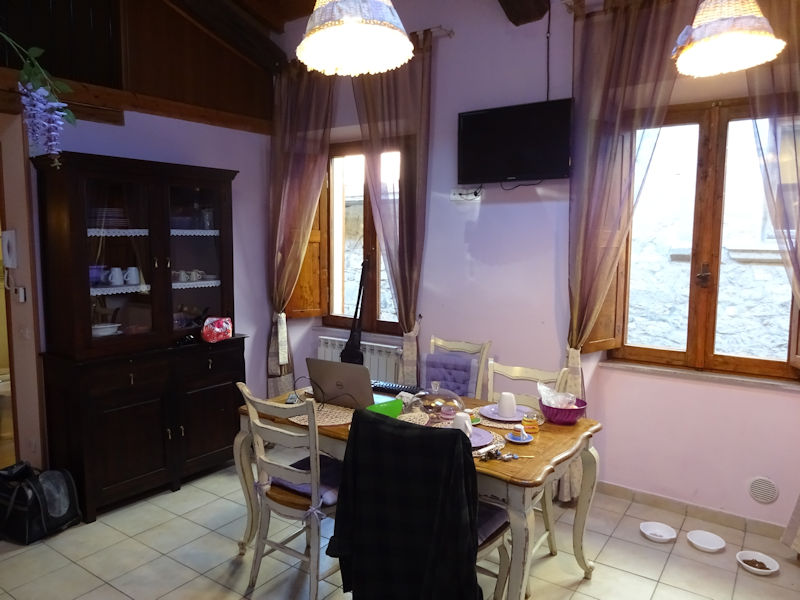
Back to the Violet Apartment in the Suite del Borgo
Tomorrow: Fiumicino airport and Ostia Antiqua





































































